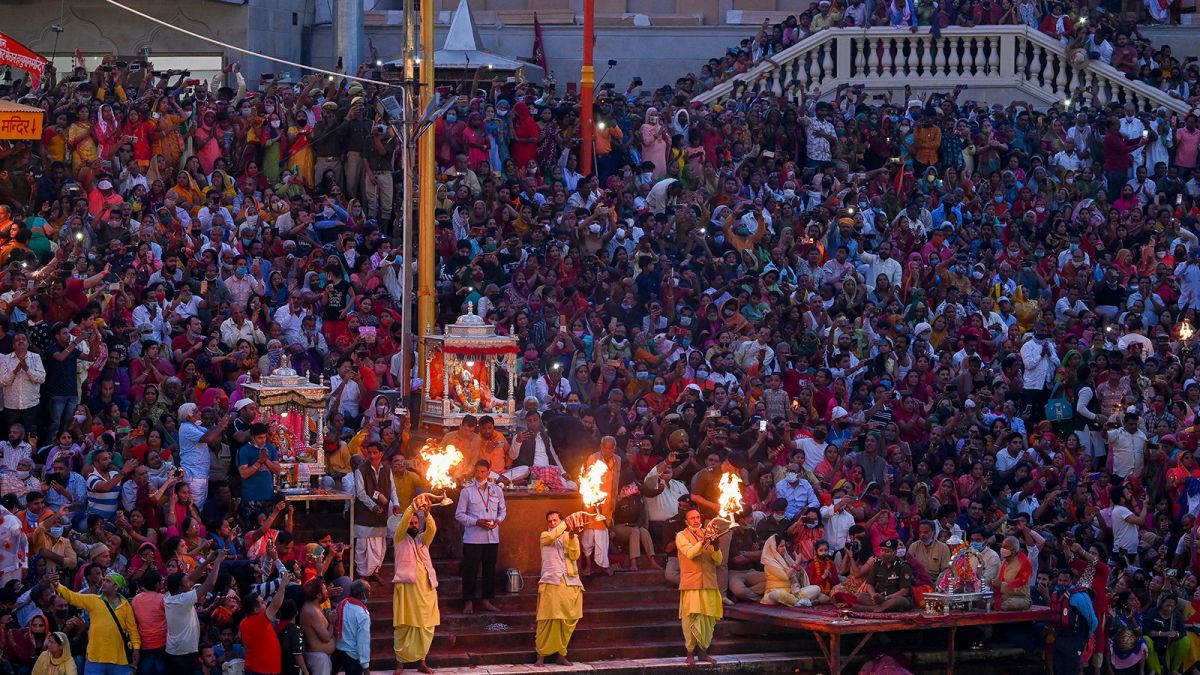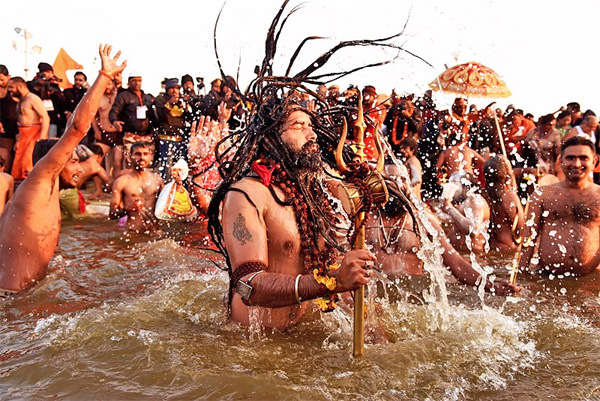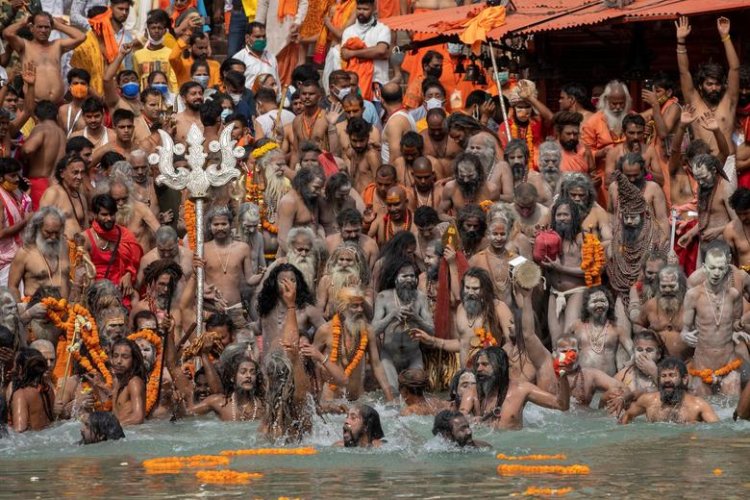Kumbh Mela
Kumbh Mela (the festival of the sacred Pitcher) is the largest peaceful congregation of pilgrims on earth, during which participants bathe or take a dip in a sacred river. Devotees believe that by bathing in the Ganges one is freed from sins liberating her/him from the cycle of birth and death. Millions of people reach the place without any invitation. The congregation includes ascetics, saints, sadhus, aspirants-kalpavasis and visitors.
Celebrating a mythological event in the life of a deity or an auspicious astrological period, the melas attract enormous numbers of pilgrims from all over the country. The greatest of these, the Kumbha Mela, is a riverside festival held four times every twelve years, rotating between Allahabad at the confluence of the Ganges, Yamuna and Saraswati rivers; Nasik on the Godavari River; Ujjain on the Sipra River; and Hardwar on the Ganges River. Bathing in these rivers during the Kumbha Mela is considered an endeavor of great merit, cleansing both body and spirit. The Allahabad and Hardwar festivals are routinely attended by five million or more pilgrims (13 million visited Allahabad in 1977, 18 million in 1989, and nearly 24 million in 2001) thus the Kumbha Mela is the largest religious gathering in the world. It also one of the oldest.

Sangam
Prayag in modern-day Allahabad is believed to be the most important pilgrimage centre for Hindus. Traditionally river confluences are regarded as auspicious places, but in Sangam, the significance of the confluence is most pious because here, the holy Ganga, Yamuna and the mythical Saraswati meet to become one.
Sangam Point
This is the point where the brown water of the Ganga meets the green water of the Yamuna, along with the mythical Saraswati, which remains unseen but believed to run underground. It is located about 7 km from Civil Lines, overlooked by the eastern ramparts of the Akbar Fort.
Wide flood plains and muddy banks protrude towards the sacred Sangam. At the mid-river point priests perch on small platforms to perform puja and assist the devout in their ritual ablutions in the shallow waters. A dip in the Sangam water is supposed to be the holiest of the holy pilgrimages for the devout Hindu. Boats to the Sangam can be rented by pilgrims and tourists alike at the ghat near the fort. It is during the Maha Kumbh/Kumbh that the Sangam truly comes alive, attracting the devout from all across the country.
Why sangam is called tirtharaj ?
According to legends, Vishnu was carrying a Kumbh (pot) of amrit (nectar), when a scuffle broke out and four drops were spilled. They fell to earth at the four Tirthas of Prayag, Haridwar, Nasik and Ujjain. A tirtha is a place where the devout can attain salvation. The event is commemorated every three years by the Kumbh Mela, held at each tirtha in turn; the Sangam is known as Tirtharaj, the ‘King of Tirthas’ and here the Kumbh is held once in every twelve years, which is the greatest and holiest of all.

Administrative Facilities
The Maha Kumbh Mela is the largest religious congregation in India, attended by millions. The over month-long fair is marked by the construction of a massive tented township, completAe with cottages, huts, platforms, civic facilities, administrative and security measures. It is organized immaculately by the government, the local authorities and the police. The mela is especially renowned for the presence of an extraordinary array of religious ascetics – sadhus and mahants – enticed from remote hideaways in forests, mountains and caves. Once astrologers have determined the propitious bathing time or Kumbhayog, the first to hit the water is by legions of Naga Sadhus or Naga Babas, who cover their naked bodies with ash and wear hair in long dreadlocks. The sadhus, who see themselves as guardians of the faith, approach the confluence at the scheduled time with all the pomp and bravado of a charging army. The most recent Maha Kumbh Mela was held in 2013 and the next is due in 2025.

It's the mythological history of India and the sacred religious texts that bind us carnal souls to an eternal hope - things will be better, without the ever-imminent fear of them getting worse that cripples us here. "An eternal life free of sins" is the promise that comes attached with the magnificent event of Kumbh Mela. It's a promise to which millions want to be bound with, and it is this promise that has made Kumbh Mela what it is today.

Depending on what position the Sun, Moon, and Jupiter hold in that period in different zodiac signs, the venue for Kumbh Mela is decided. The calculations have been provided below for information:
Kumbh Mela at Allahabad
when Jupiter is in Aries or Taurus and Sun and Moon are in Capricorn during the Hindu month of Magha (January-February).
Kumbh Mela at Haridwar
when Jupiter is in Aquarius and Sun is in Aries during the Hindu month of Chaitra (March-April).
Kumbh Mela at Ujjain
when Jupiter is in Leo and Sun is in Aries, or when all three are in Libra during the Hindu month of Vaisakha (April-May).
Kumbh Mela at Nasik
when Sun and Jupiter are in Leo during the Hindu month of Bhadraprada (August-September).
It's believed that the festival of Kumbh Mela is arround 2000 year old. The first written account of Kumbh Mela was found in the account of Chinese traveller Xuanzang , who visited the india during the time of king of HARSHAVARDHANA .
















